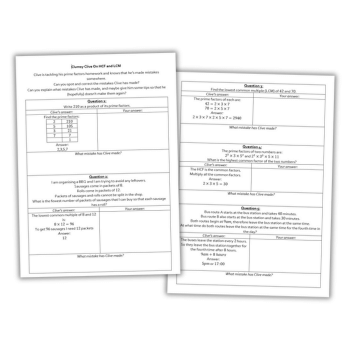This prime factoring worksheet focuses on Clive, who is tackling his prime factors homework and knows that he’s made mistakes somewhere.
Can pupils spot and correct the mistakes Clive has made? Can they explain what mistakes Clive has made, and maybe give him some tips so that he (hopefully) doesn’t make them again?
Prime factoring worksheet
Question 1
Write 210 as a product of its prime factors.
Question 2
I am organising a BBQ and am trying to avoid any leftovers. Sausages come in packets of 8. Rolls come in packets of 12. Packets of sausages and rolls cannot be split in the shop. What is the fewest number of packets of sausages that I can buy so that each sausage has a roll?
Question 3
Find the lowest common multiple of 42 and 70.
Question 4
The prime factors of two numbers are: 23 x 3 x 52 and 22 x 33 x 5 x 11. What is the highest common factor of the two numbers?
Question 5
Bus route A starts at the bus station and takes 40 minutes. Bus route B also starts at the bus station and takes 30 minutes.
Both routes begin at 9am, therefore leave the bus station at the same time. At what time do both routes leave the bus station at the same time for the fourth time in the day?
Andy Lutwyche creates maths resources. Find more in his TES shop. You can also follow him on X at @andylutwyche.











